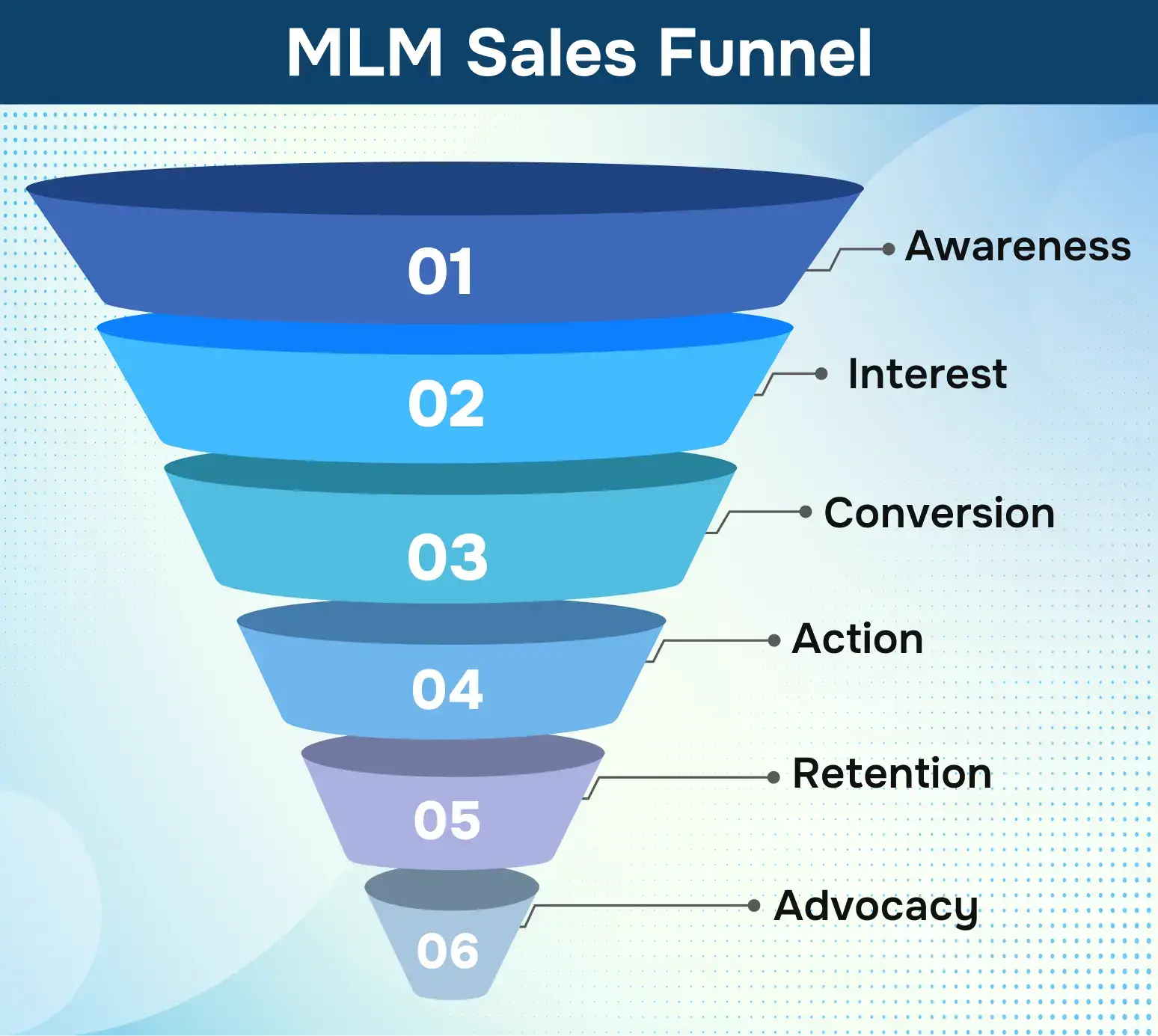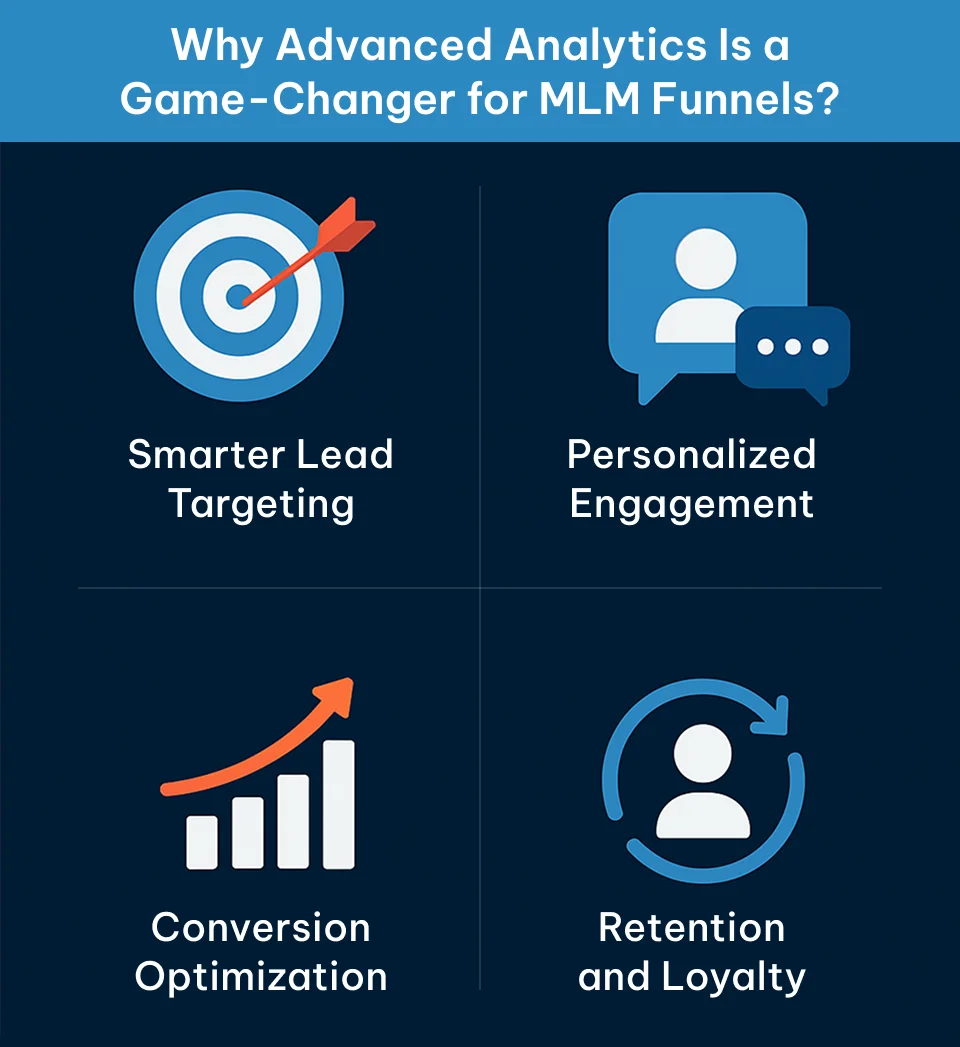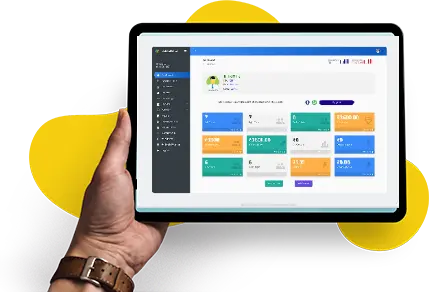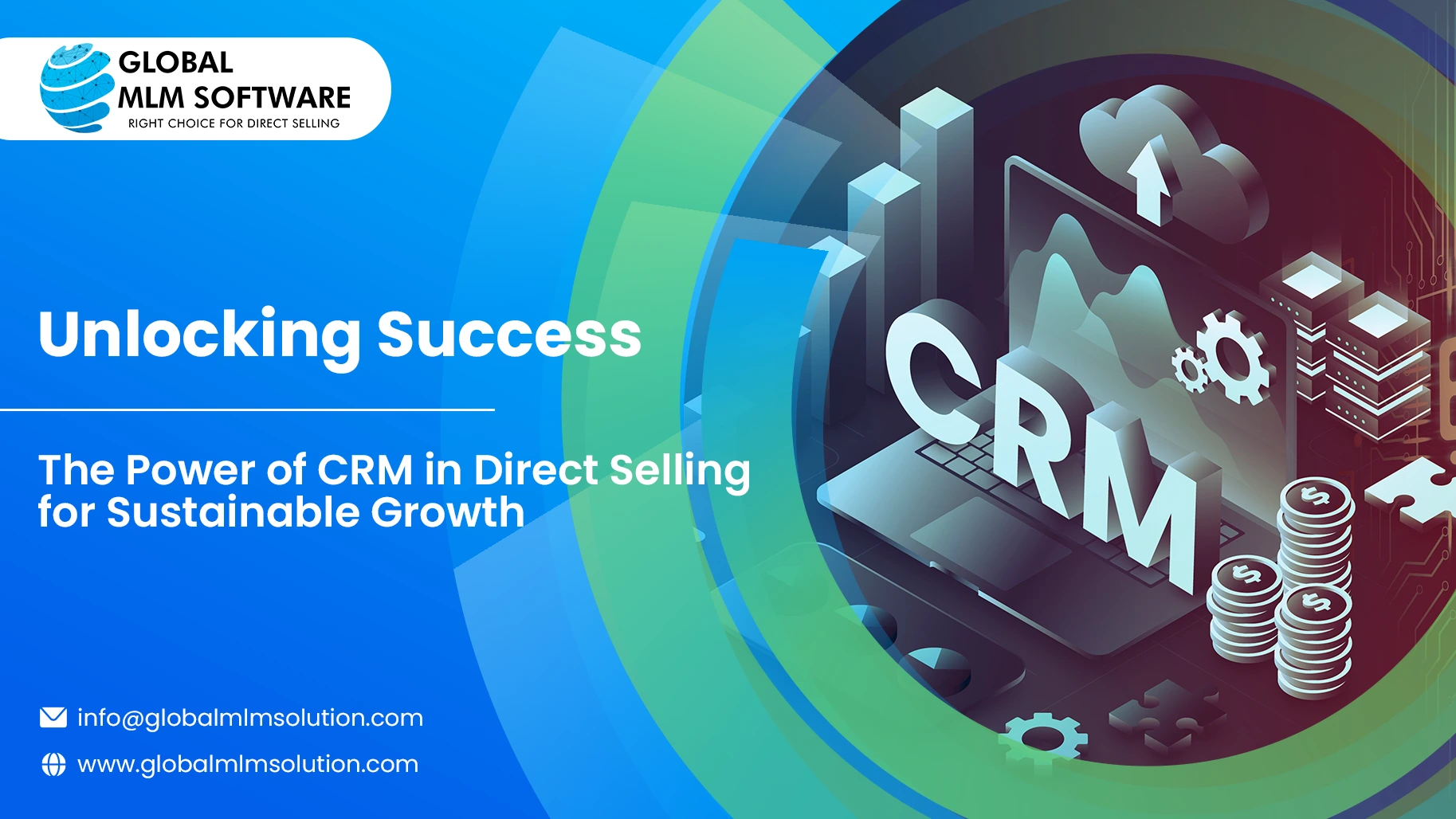It’s impossible to build a high-converting sales funnel for network marketing without leveraging advanced analytics. At least, not better than those MLM businesses that are utilizing it to identify high-value prospects, predict churn, and optimize every sales funnel stage.
If you are not using advanced analytics to improve your existing MLM sales funnel system, you are losing out on gaining visibility, attracting prospects, and acquiring new customers.
So, no more “Why am I not getting distributors or customers?”
Let’s work together to optimize your MLM sales funnel with the power of advanced analytics.
This Article Contains:
Understanding the Network Marketing Sales Funnel
Before exploring how to use Advanced Analytics for optimizing the funnel performance, let’s first understand what a network marketing sales funnel is. But if you are already aware of it, feel free to skip this section and jump directly to the next one.
For readers who want to understand the network marketing sales funnel, here’s the simplest possible definition:
“Network marketing sales funnel is the system implemented by MLM businesses that guides the prospects from the awareness stage to post conversion.”
While the traditional sales funnel only targets customers, the network marketing sales funnel targets two different yet interlinked audiences simultaneously:
Customers who are interested in buying your products.
Distributors who are interested in becoming a part of your business by selling your products.
We mentioned the awareness stage and post-conversion in the definition. Overall, there are five stages in total, which we are going to discuss in detail.

1) Awareness
At the awareness stage, the primary objective is to familiarize prospects with your business. There can be secondary goals as well, such as letting people know about your CSR activities, events, and spreading knowledge regarding the domain that aligns with your mission.
In terms of network marketing, highlighting your product benefits, showcasing new launches, and posting a social media post regarding your company’s mission are all ways of spreading awareness amongst the customers.
Now, there are distributors too! So, the methods almost stay the same at the awareness stage, but the content differs. For instance, you can explain the business opportunity in a post, drive the traffic to your website page that explains “why distributors should join our business,” etc.
Once the customer or distributor knows about your business, it’s time to move them down the funnel to the interest stage.
2) Interest
The customers and distributors already know that your business exists. What’s next? The need to trust you and get curious about it.
If they have already followed you on social media or signed up for the newsletter, things are in your favor.
You can provide customers with value-driven resources, such as a diet plan if you are into nutrition supplements or skincare hacks if you are into skincare products. Here, you can subtly mention your products to generate more interest.
While the above-mentioned examples work for distributors too, there can be exclusive interest-generating content as well. For instance, you can organize a webinar covering the “Essentials of Sales in Network Marketing” and also give real-life examples of how it worked for your business. If they align with the basics, they’ll stick around longer and eventually move to the conversion stage.
COMPLIANCE FACT: Never post top earners’ experience as a testimonial to generate interest, as it is considered misleading. To know more such facts about the MLM industry, check our MLM compliance checklist.
3) Conversion
Now, as your customers and distributors are regularly engaging with your content and showing interest, it’s time for your products or business opportunity to reach their respective carts.
In the conversion stage, your MLM prospects decide to buy a product. In the case of distributors, they choose whether to go forward with the business opportunity.
Suppose a prospect has been following your wellness brand and watching product demos on social media. At this stage, they are offered a limited-time discount on a starter kit or invited to a free trial webinar about earning potential. These nudges push them from “just interested” to actually making a purchase or signing up as a distributor.
4) Action
In the action stage, the goal is to seal the deal by making the sale or onboarding the distributor. They have already made their minds; it’s just the final stamp that’s pending.
In the case of customers, methods such as abandoned cart tracking can be used to move them forward in the funnel.
When it comes to distributors, the process is usually offline, where sponsors continuously take follow-ups to ensure the prospect stays engaged and joins the downline.
It’s also helpful to provide your distributors with MLM script templates to guide their conversations throughout the conversion process.
5) Retention
Once a customer or a distributor gets converted, the real task begins; MLM businesses need to keep them motivated to ensure long-term retention.
Let’s first discuss how the retention stage works for customers.
Once a customer makes a purchase, they would expect results based on the product. However, when expected results are not achieved, you’ll lose the customer forever. Therefore, taking feedback on product performance is essential.
In case the product doesn’t meet the expectations, your customer service department can recommend alternatives at discounted prices, keeping the customer active.
Similarly, offering loyalty programs, community access, etc., works well for customer retention. It’s almost the same whether you are an MLM business or a traditional e-commerce business.
However, an edge you get here is the support of distributors. When the end customer is converted by a distributor, your business gets additional support. Here, the distributor can take care of customer retention on your behalf.
But what about retaining distributors?
That’s where MLM businesses need to strengthen their network marketing sales funnel. One of the best ways to retain distributors is by providing them with generous monetary benefits and making them feel valued, which is possible using MLM rewards.
You can keep them motivated by publicly acknowledging their efforts, giving them additional bonuses, and who doesn’t love sponsored trips?
However, how would you improve your network marketing sales funnel and take it to the next level?
That’s where advanced analytics is used, which we will discuss next.
Advanced Analytics: What It Really Means in Terms of MLM Sales Funnel System
When most people hear “analytics,” they think of tracking metrics like clicks and conversions. However, it goes beyond that, especially in the case of a network marketing sales funnel. You can utilize data science, AI, and predictive modeling to understand user behavior, forecast outcomes, and optimize the funnel at every stage. Let’s see how.
1) Lead Generation (Top of the Funnel)
When your network marketing sales funnel is volume-driven, it attracts several individuals who are not genuine prospects, which dilutes the overall funnel quality.
Therefore, it’s necessary to make your funnel precision-driven rather than volume-driven.
You can implement machine learning models to analyze the customer information, such as demographics, online behavior, engagement type, etc., and match it with the target audience. Based on that, you can score your leads. The higher the score, the better the chances of conversion. This is called predictive lead scoring. According to FasterCapital, companies using predictive analytics in their sales processes see a 27% increase in sales productivity and a 33% boost in sales revenue.
Once the machine learning models are set, you can also segment the target audience into different groups. In MLM lead generation, it can be distributors and customers on a higher level. It can be further segmented.
For instance, in the case of distributors, you can segment the audience into:
People looking for a secondary income source
People who are already distributors but are looking to switch
Sales professionals who would be interested in network marketing opportunities
Homemakers who want work flexibility
This can be even further personalized based upon your industry, such as targeting gym instructors if it’s a fitness-related product, salon and spa owners for skin and hair care products, etc.
After scoring and segmenting, you can share targeted content to attract the audience and move forward in the funnel.
2) Engagement (Middle of the Funnel)
Now that your network marketing sales funnel has identified prospects, it’s time to nurture the leads based on their segmentation, with the help of advanced analytics.
In this stage, you need to track metrics for your multi-channel interaction (webinars, email opens, and link clicks), course sign-ups, etc.
Again, it works differently for customers and distributors.
For customers, you can track their social media interactions, such as comments and likes, or if they visited the website, you can run targeted ads.
For distributors, the metrics are more likely to be professional interactions. For instance, attendance in your webinars, completion of your courses, etc.
Now, where does advanced analytics play its role?
Once different activities are tracked, marketers can use advanced analytics to understand the user behavior and create a complete user profile.
Let’s give an example.
There’s a prospect named John, who started following your social media page. This means the lead is generated and the person is in the engagement stage.
Now, he comments on one of your event posts that he’d like to know more about the business opportunity. You can share the website link or a PDF presenting all the information required.
While the prospect is taking its time in evaluation, you can share a request to join the upcoming webinar.
After attending the webinar, there could be a positive or negative impact on the engagement based on how the webinar content is absorbed.
Using MLM sales funnel analytics, there is an existing user profile based on the interactions. The machine learning model detects the changes whether the person moves forward or backward in the funnel.
For instance, if the engagement level decreases, the advanced analytics can point it out, and you can take further action, such as requesting to join the course or attend another virtual event.
If it’s positive, let’s say, the prospect joined your course and completed it, it’s near the conversion point.
So, you can take the step accordingly by requesting to try out product samples or sharing an email regarding distributors’ work-life flexibility.
3) Conversion (Bottom of the Funnel)
All the hot, nurtured, leads are detected and segmented based on the parameters you set using MLM sales funnel analytics.
Now that they are at the bottom of the funnel, MLM sales funnel analytics is applied to optimize the final decision-making process, whether the prospect becomes a customer or a distributor.
This includes conversion path analytics to pinpoint the hurdles that prevent prospects from converting.
For customers, you can track cart abandonment, what made them unsubscribe from the newsletter, or if any request is shared by the customer.
In the case of distributors, there can be drop-offs like incomplete enrollment forms or stalled subscription sign-ups.
You can conduct multivariate A/B testing to experiment with pricing structures, call-to-action, form designs, and offer bundling, and identify the highest-performing combination.
Perhaps different versions work well with different segments or user profiles. You can align these variations that maximize the performance, implement them, and keep optimizing.
You can also run cohort network marketing analytics on segments to understand the overall behavior of various segments. Accordingly, you can identify the segment that’s converting relatively easily and align your marketing with them to gain a further conversion boost.
4) Retention (Post Conversion/After Sign Up)
Now that your prospects are your customers or distributors, there will be a shift in the objective. The network marketing sales funnel analytics will be used to maximize the retention and increase the lifetime value of the customers and distributors. A mere 5% increase in retention can improve the profit of your MLM by 25-95%.
You can further define the objectives, such as:
Identifying and reducing churn risks
Uncovering patterns to drive loyalty
Detect activity drop-off in segments and individual customer profiles
Developing cross-selling and upselling strategies
Let’s discuss in detail how to use MLM sales funnel analytics for retention.
Develop a churn prediction model, powered by machine learning, that analyzes behavioral signals. Some behavioral signals can be the same, and others can be different for customers and distributors.
For instance, you can analyze the drop-off in customers’ purchases at the individual level, and the same can be done for identifying distributors’ bulk procurement.
Based on the change in behavior, the advanced analytics can define a churn probability score. And for individuals whose churn score is higher, the business can intervene and take action before the relationship is lost.
However, the action required differs.
In the case of customers, you can offer discounts or require feedback to make customers feel valued.
In the case of distributors, it’s better to have a dedicated support team that handles such issues. Perhaps you can also communicate with the distributors’ upline and keep them motivated.
Similarly, implement RFM (Recency, Frequency, Monetary) analytics to further segment customers and distributors into “champions” (high-value, frequent buyers/distributors) and “at-risk” (low value, showing high decrement in purchases).
So, what metrics do you track under RFM analytics?
How recently they engaged
The purchase frequency
Total value generated
Based on that, you can score and segment them. This helps in optimizing your resource allocation, prioritizing high-potential individuals.
For instance, you can provide champion distributors with exclusive training, an email appreciating their hard work, or maybe premium support in growing their downline.
Why Advanced Analytics Is a Game-Changer for MLM Funnels?
Traditional MLM funnels rely on volume-driven tactics. That means bringing in as many people as possible and hoping that some will convert as they move down the funnel. The problem with this approach is that it’s cost-intensive, and still, the conversion is low as it's not targeted. Even if the conversion takes place, retention could be challenging, as the converted audience may or may not align with your brand.
Advanced analytics changes this dynamic entirely by shifting the funnel from guesswork to a precision-driven, targeted approach.

1) Smarter Lead Targeting
Predictive lead scoring in network marketing ensures that only high-potential prospects, whether customers or distributors, enter the funnel, selected based on their persona that aligns with the business’s product and opportunities.
Lookalike modeling identifies audiences similar to your best-performing customers and distributors.
It saves the cost that businesses incur when they target a larger audience base, even though they don’t align with your business.
2) Personalized Engagement
Not all of your products are for all of your customers and distributors. You need to track their activities using behavioral analytics based on what posts, emails, and videos engage your customers and distributors the most. Accordingly, you can tailor your approach, boosting trust and engagement.
3) Conversion Optimization
For funnel stage optimization and to maximize conversion, MLM sales funnel analytics is what you need to uncover drop-off points during enrollment, signups, and checkouts. Based on analytics, ML models can draw abandonment patterns and help you optimize your approach.
Multivariate A/B testing and cohort analysis reveal what really drives sign-ups for various segments. You can cater to them accordingly, reducing funnel leakage.
4) Retention and Loyalty
No more unexplained churn. Network marketing sales funnel advanced analytics will help you to detect the high-performing “at-risk” customers and distributors and save the relationship before it ends. This is done by calculating churn score based on user activity.
RFM analysis and customer lifetime value forecasting guide retention efforts and loyalty campaigns.
Key Metrics That Matter Most in MLM Funnels
There are limitless metrics to track in each stage of your MLM funnel, depending on how detailed you want the user profile to be.
In this section, we will list out the key metrics and their impact for every stage
1) Metrics to Track for Awareness Stage
a) Lead Acquisition Cost (LAC)
The average cost to acquire a new lead via different marketing channels, such as ads, social media, referrals, or campaigns.
Shows the efficiency of your marketing spend, helps compare channel performance, and optimizes the approach accordingly. It will help you understand from which marketing channels you get the high-performing customers and distributors’ segments.
b) Lead Volume
The total number of new leads captured within a given period.
Tracks reach and funnel growth, but must be paired with quality analysis to ensure that lead volume is calculated for high-value prospects.
c) Lead Quality / Predictive Lead Score
A score based on demographics, engagement signals, and behavioral data. There can be further parameters, such as different types of engagements, interaction level, etc., to develop the scoring formula.
Helps prioritize leads most likely to convert into customers or distributors. The higher the score, the more likely the conversion.
d) Traffic-to-Lead Conversion Rate
Percentage of visitors who become leads (opt-ins, sign-ups, inquiries).
Measures the landing page and offer effectiveness at converting attention into interest. Based on that, you can run A/B testing to identify what works for which segment.
e) Channel Effectiveness
Performance of each channel (social, email, ads, referrals) in generating qualified leads.
Optimizes marketing budget allocation to the highest-performing sources.
f) Cost Per Thousand Impressions (CPM) / Click-Through Rate (CTR)
CPM shows cost per exposure; CTR shows the percentage who clicked through ads/content.
Calculates the efficiency of awareness campaigns before leads are captured. You can optimize the campaigns accordingly.
2) Metrics to Track for Engagement Stage
a) Engagement Rate with Content
Measures interaction with emails, webinars, videos, and social posts (open rates, click-throughs, watch time, comments).
Shows which content resonates and builds trust at scale. You can optimize the content accordingly by identifying what is delivering low engagement and making efforts to eliminate it.
b) Follow-Up Response Rate
Percentage of leads who reply or take action after follow-up, such as requesting feedback, sending a purchase link, sharing a valuable resource, etc.
Highlights how well your team or automation is maintaining prospect interest.
c) Movement Down the Funnel
Average time leads spend in the engagement stage before moving to conversion or dropping off.
Identifies bottlenecks; if leads are “stuck,” nurturing strategy needs adjustment.
3) Metrics to Track for Conversion Stage
a) Overall Conversion Rate
Percentage of leads who complete a purchase or join as distributors.
Core indicator of funnel effectiveness and sales readiness.
b) Average Order Value (AOV)
Average purchase value, whether it is an individual order by a customer or a bulk procurement by a distributor
Helps in pricing the MLM products better or identifying variants that can be released.
c) Time-to-Conversion
Average time it takes from becoming a prospect to a customer or distributor.
A shorter cycle indicates stronger messaging and easier conversion. Help you identify segments that can be converted into a shorter span.
d) Drop Out Rates
Percentage of prospects who drop off just before the conversion.
Highlights room for improvement in the checkout process, enrollment forms, etc.
3) Metrics to Track for Retention Stage
a) Customer Retention Rate (CRR)
The percentage of customers who continue buying products and don’t stop after the first purchase.
Shows product stickiness and brand loyalty.
b) Distributor Retention / Active Rate
Percentage of enrolled distributors who remain active (ordering products, recruiting, or engaging). But it’s essential that they make end-user sales to be considered active.
A critical metric for MLM business stability, showing that distributors are interested and engaged.
c) Order Frequency
Average number of orders per customer/distributor within a defined period.
Indicates how often customers replenish products or distributors place orders, and explains patterns in end sales.
d) Customer Lifetime Value (CLV / LTV)
The projected revenue a customer/distributor generates during their entire relationship with the business.
Helps identify the most valuable segments to focus retention efforts.
e) Churn Rate
Percentage of customers/distributors who stop purchasing or disengage after a period.
Reveals gaps in product experience, support, or distributor motivation.
Analytics Tools & Technologies for MLM Sales Funnel Success
There are multiple aspects in data analytics where tools and technologies can provide you with exceptional insights. It’s necessary that you work with the right stack of tools, always, to bring the best for your MLM business.
1) Data Collection and Tracking Tools
There are several touch points where your customers and distributors engage with your business. Skipping even one means losing vital information that can help you understand your user behavior better.
Different tools are used for different checkpoints, such as:
Google Analytics, sales funnel heatmaps, and Google Search Console for understanding the content performance of your website and how visitors engage with it.
Dedicated social media analytics tools, such as Hootsuite, for understanding customer/distributor engagement with your social media accounts and developing user profiles accordingly.
2) Customer and Distributor Relationship Analytics
You need to have insight into each distributor’s move to execute the retention stage perfectly in the MLM sales funnel. Here are some points where relationship management tools can be helpful:
An MLM back-office tool for understanding distributor activity, tracking their purchases, and getting insights into downline performance.
CRM tools for centralizing individual distributor and customer information, tracking their lifecycle, creating individual buyer personas, and segmenting them accordingly.
Email and marketing MLM automation tools, such as ActiveCampaign, to nurture leads.
3) Business Intelligence and Visualization
Data collection tools will provide you with the raw data or basic insight, or you’ll need dedicated business intelligence tools to identify patterns for real-time sales funnel reporting.
Based on the network marketing sales funnel KPIs you set, you can visualize the funnel performance using tools such as Power BI and Tableau
For small MLM companies, Google Looker Studio is an affordable option for report creation.
Back-office MLM software can also help you create reports and analytics that you can use to take informed actions.
4) Predictive Advanced Analytics for MLM
To take your decision-making to the next level, predictive analytics is one of the top-notch ways that you ought to implement. Here’s how you can do it:
AI-driven lead scoring tools such as MadKudu and InsideSales can help you rank leads and identify “easy-to-convert” ones to direct your efforts correctly.
Churn prediction tools help you save your relationships with customers and distributors before they end. These tools work on metrics such as reduction in activity, purchase value, negative rating, etc., to evaluate the customers’/distributors’ health.
5) Testing and Optimization Tools
Your sales funnel must be working fine, but there’s always room for optimization. And you don’t need to do that alone. You have dedicated tools that will help you collect the performance data and suggest ways to improve.
It’s possible to do A/B testing on every customer checkpoint, whether it’s the website, enrollment forms, sign-up pages, etc. You can use tools such as Optimizely and Google Optimize to perform these tests and come up with a better user experience, improving conversion and retention.
Heatmap tools such as Hotjar not only collect data but also provide valuable information on what’s working for you and what isn’t. Based on the user’s engagement with your website, you can make changes in your content, CTAs, table, media elements, etc.
One of the easiest ways to optimize the funnel is to request feedback and conduct surveys. Ask your regular content consumers what improvement they expect and make the changes accordingly.
Key Takeaways
Building a high-converting network marketing sales funnel is more than just moving the customer from the top of the funnel to the bottom. It’s about creating data-driven journeys for each prospect; to provide them with an experience that builds a bond of trust, loyalty, and value for both parties.
You can use MLM sales funnel analytics using dedicated tools at every stage, eliminating the guesswork. By adopting this approach, you’ll outperform your competitors by creating a system that takes each buyer persona, each user profile, on a personalized level.
FAQs
1. What is a sales funnel in network marketing?
Sales funnel in network marketing is a step-by-step process or journey that prospects follow to turn into loyal customers or life-long distributors.
2. Which analytics tools are best for network marketing sales funnels?
There are dedicated tools to handle each aspect of the network marketing sales funnel. These tools should integrate with MLM software, such as the Global MLM, and track various distributor/customer journeys:
Web & Funnel Analytics: GA4, Mixpanel
CRM & Lead Scoring: HubSpot, Zoho, Salesforce
Engagement Tracking: Amplitude, Kissmetrics
BI & Reporting: Tableau, Power BI, Looker Data
3. Can advanced analytics help me recruit more distributors?
Yes, advanced analytics can help you recruit more people by introducing leads that align well with the business and nurturing them with precise targeting.
4. What KPIs should I track in my network marketing funnel?
There are hundreds of KPI that you can track in your network marketing funnel. However, some of the important ones are as follows:
Lead Acquisition Cost (LAC)
Lead-to-Customer/Distributor
Conversion Rate
Engagement Rate
Average Order Value (AOV)
Recruitment Rate
Churn Rate
Customer Lifetime Value (CLV)
5. Is advanced analytics suitable for small network marketing teams?
Yes, advanced analytics is suitable for small network marketing teams. In fact, MLM businesses must use advanced analytics features irrespective of their size.
Disclaimer: Global MLM Software do not endorse any companies or products mentioned in this article. The content is derived from publicly available resources and does not favor any specific organizations, individuals or products.








